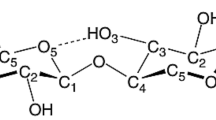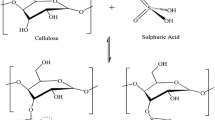Abstract
In this study nanocellulose and carboxylated nanocellulose of Hybrid Napier CO5 grass and Desmostachya Bipinnata grass were prepared and used as an adsorbent for water treatment. Conventional acid hydrolysis was used to extract cellulose from Desmostachya Bipinnata grass and green eco-friendly hydrogen peroxide bleaching method and meghamite as catalyst was used to extract nanocellulose from hybrid napier CO5. Catalytic conversion of Hybrid Napier CO5 green grass CMF to nanocellulose involves a one pot synthesis carried out by the cleavage of beta 1,4 glycosidic bond within the cellulosic network. Maghemite (ϒ-Fe2O3) has shown to be a good catalyst for the conversion of CMF to nanocellulose wherein depolymerisation of cellulose occurs. Scanning electron Microscopy (SEM) images showed the needle like CNC and rod like CMF indicating the formation of nanocellulose. X-ray diffraction studies showed that the amorphous region was eliminated during acid hydrolysis which led to more crystallinity in CNC than CMF. Fourier Transform Infrared spectra (FT-IR) showed the chemical composition of raw and modified nanocelluloses, which were identical but quite different from respective raw samples. FT-IR and XRD confirms the formation of nanocelulose of hybrid napier after the treatment with the catalyst. Both the modified fodder grass nanocelluloses have shown good adsorption efficiency towards the adsorption of Evans blue dye. The prepared adsorbents are recyclable with good adsorption efficiency.
Graphical Abstract











Similar content being viewed by others
Data Availability
All the data required for this article have been provided in the article itself and any information further required will be provided.
Code Availability
No software coding is involved in this article.
References
Ismail M, Akhtar K, Khan MI, Kamal T (2019) Pollution, toxicity and carcinogenicity of organic dyes and their catalytic bio-remediation. Curr Pharm Des 25(34):3645–3663
Liu L, Gao ZY, Su XP, Chen X, Jiang L, Yao JM (2015) Adsorption removal of dyes from single and binary solutions using a cellulose-based bioadsorbent. ACS Sustain Chem Eng 3(3):432–442
Yagub MT, Sen TK, Afroze S, Ang HM (2014) Dye and its removal from aqueous solution by adsorption: a review. Adv Colloid Interface Sci 209:172–184
Al-Ghouti MA, Khraisheh MAM, Allen SJ, Ahmad MN (2003) The removal of dyes from textile wastewater: a study of the physical characteristics and adsorption mechanisms of diatomaceous earth. Environ Manage Today 69(3):229–238
George J, Sabapathi SN (2015) Cellulose nanocrystals: synthesis, functional properties, and applications. Nanotechnol Sci Appl 8:45
Mu R, Hong X, Ni Y, Li Y, Pang J, Wang Q, Zheng Y (2019) Recent trends and applications of cellulose nanocrystals in food industry. Trends Food Sci Technol 93:136–144
Abeer MM, Mohd Amin MCI, Martin C (2014) A review of bacterial cellulose-based drug delivery systems: their biochemistry, current approaches and future prospects. J Pharm Pharmacol 66(8):1047–1061
Long W, Ouyang H, Hu X, Liu M, Zhang X, Feng Y, Wei Y (2021) State-of-art review on preparation, surface functionalization and biomedical applications of cellulose nanocrystals-based materials. Int J Biol Macromol 186:591–615
Tang J, Sisler J, Grishkewich N, Tam KC (2017) Functionalization of cellulose nanocrystals for advanced applications. Int J Biol Macromol 494:397–409
Kassab Z, Abdellaoui Y, Salim MH, Bouhfid R, El Achaby M (2020) Micro-and nano-celluloses derived from hemp stalks and their effect as polymer reinforcing materials. Carbohydr Polym 245:116506
Laurenti JP (1984) Characteristics of coupled-mode optical filters. J Appl Phys 56(1):81–87
de Carvalho Benini KCC, Voorwald HJC, Cioffi MOH, Rezende MC, Arantes V (2018) Preparation of nanocellulose from Imperata brasiliensis grass using Taguchi method. Carbohydr Polym 192:337–346
Somseemee O, Sae-Oui P, Siriwong C (2021) Reinforcement of surface-modified cellulose nanofibrils extracted from Napier grass stem in natural rubber composites. Ind Crops Prod 171:113881
Khyade VB, Pawar SS, Sarwade JP (2018) Novel sacrificial medicinal repositories: halfa grass, Desmostachya bipinnata (L.) and cogon grass, Imperata cylindrica (L.). World Sci News 100:35–50
Das A, Patel DP, Lal R, Kumar M, Ramkrushna GI, Layek J, Shivakumar BG (2016) Impact of fodder grasses and organic amendments on productivity and soil and crop quality in a subtropical region of eastern Himalayas, India. Agric Ecosyst Environ 216:274–282
Gulzar S, Khan MA, Liu X (2007) Seed germination strategies of Desmostachya bipinnata: a fodder crop for saline soils. Rangel Ecol Manage 60(4):401–407
Tao H, Lavoine N, Jiang F, Tang J, Lin N (2020) Reducing end modification on cellulose nanocrystals: strategy, characterization, applications and challenges. Nanoscale Horiz 5(4):607–627
Aziz T, Ullah A, Fan H, Ullah R, Haq F, Khan FU, Wei J (2021) Cellulose nanocrystals applications in health, medicine and catalysis. J Polym Environ 29(7):2062–2071
Domingues RM, Gomes ME, Reis RL (2014) The potential of cellulose nanocrystals in tissue engineering strategies. Biomacromol 15(7):2327–2346
Wohlhauser S, Delepierre G, Labet M, Morandi G, Thielemans W, Weder C, Zoppe JO (2018) Grafting polymers from cellulose nanocrystals: synthesis, properties, and applications. Macromolecules 51(16):6157–6189
Suppiah DD, Johan MR (2019) Catalytic conversion of microcrystalline cellulose to nanocellulose using iron oxide catalysts. 58(2):265–270
Lee HV, Hamid SBA, Zain SK (2014) Conversion of lignocellulosic biomass to nanocellulose: structure and chemical process. Sci World J. https://doi.org/10.1155/2014/631013
Negishi Y, Yamane M, Kurihara N, Endo-Takahashi Y, Sashida S, Takagi N, Maruyama K (2015) Enhancement of blood–brain barrier permeability and delivery of antisense oligonucleotides or plasmid DNA to the brain by the combination of bubble liposomes and high-intensity focused ultrasound. Pharmaceutics 7(3):344–362
Pennells J, Lin TY, Schmidt S, Gamage H, Godwin ID, Erickson TE, Amiralian N (2018) Effects of the growth environment on the yield and material properties of nanocellulose derived from the Australian desert grass Triodia. Ind Crops Prod 126:238–249
Amiralian N, Annamalai PK, Garvey CJ, Jiang E, Memmott P, Martin DJ (2017) High aspect ratio nanocellulose from an extremophile spinifex grass by controlled acid hydrolysis. Cellulose 24(9):3753–3766
Schimanke G, Martin M (2000) In situ XRD study of the phase transition of nanocrystalline maghemite (γ-Fe2O3) to hematite (α-Fe2O3). Solid State Ion 136:1235–1240
Mandal A, Chakrabarty D (2011) Isolation of nanocellulose from waste sugarcane bagasse (SCB) and its characterization. Carbohydr Polym 86(3):1291–1299
Barbash VA, Yashchenko OV, Gondovska AS, Deykun IM (2021) Preparation and characterization of nanocellulose obtained by TEMPO-mediated oxidation of organosolv pulp from reed stalks. Appl Nanosci. https://doi.org/10.1007/s13204-021-01749-z
Jannatyha N, Shojaee-Aliabadi S, Moslehishad M, Moradi E (2020) Comparing mechanical, barrier and antimicrobial properties of nanocellulose/CMC and nanochitosan/CMC composite films. Int J Biol Macromol 164:2323–2328
Onkarappa HS, Prakash GK, Pujar GH, Rajith Kumar CR, Betageri VS (2020) Facile synthesis and characterization of nanocellulose from Zea mays husk. Polym Compos 41(8):3153–3159
Asad M, Saba N, Asiri AM, Jawaid M, Indarti E, Wanrosli WD (2018) Preparation and characterization of nanocomposite films from oil palm pulp nanocellulose/poly (Vinyl alcohol) by casting method. Carbohydr Polym 191:103–111
Wang S, Zhang Q, Wang Z, Pu J (2020) Facile fabrication of an effective nanocellulose-based aerogel and removal of methylene blue from aqueous system. J Water Process Eng 37:101511
Zhou Y, Zhang M, Wang X, Huang Q, Min Y, Ma T, Niu J (2014) Removal of crystal violet by a novel cellulose-based adsorbent: comparison with native cellulose. Ind Eng Chem Res 53(13):5498–5506
Rana AK, Frollini E, Thakur VK (2021) Cellulose nanocrystals: pretreatments, preparation strategies, and surface functionalization. Int J Biol Macromol 182:1554–1581
Funding
This work is self-supported and it is not funded by any external agency.
Author information
Authors and Affiliations
Corresponding author
Ethics declarations
Conflict of interest
The authors do not have any conflicts of interests.
Additional information
Publisher's Note
Springer Nature remains neutral with regard to jurisdictional claims in published maps and institutional affiliations.
Rights and permissions
About this article
Cite this article
Vijayan, J.G., Prabhu, T.N. Catalytic and Non-catalytic Approach for the Synthesis of Green Functionalized Nanocellulose from Different Biomass: Properties and Adsorption Studies. Top Catal 65, 1765–1781 (2022). https://doi.org/10.1007/s11244-022-01637-y
Accepted:
Published:
Issue Date:
DOI: https://doi.org/10.1007/s11244-022-01637-y




